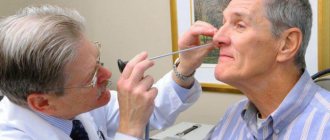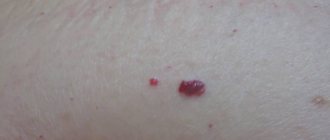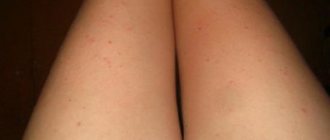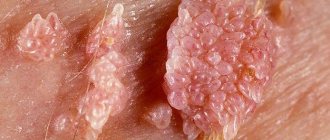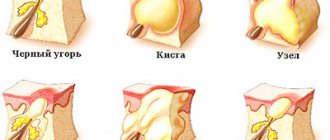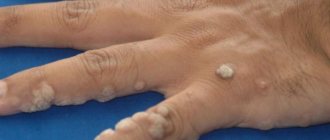Enlarged fat tissue can cause discomfort and pain. Lipoma on the buttock occurs for unknown reasons. Possible factors for its occurrence are hormonal imbalance, dysfunction of the thyroid gland, or disruption of enzymes in fatty tissues. The disease may be asymptomatic or accompanied by pain when growing or pressing on the tubercle. It is desirable to eliminate the tumor through surgery to avoid complications, inflammatory processes and tissue necrosis. Prevention of the disease helps to reduce gluteal lipoma.
Wen often grows in an “inconvenient place” - on the butt, which brings discomfort to life.
Reasons for appearance
Wen on the buttock most often occurs in patients who have a genetic predisposition to it. If close relatives have already been diagnosed with lipomatosis, in a child, regardless of his gender, in adolescence or adulthood, lipoma will begin to develop rapidly as soon as one of the risk factors comes into play:
- gluteal lipoma is formed due to serious disorders of lipid metabolism, this is one of the most common causes of lipomas;
- hormonal disbalance;
- the result of malfunction of the mechanism for regulating fat formation;
- regular violation of basic hygiene rules.
A true lipoma has a lobular structure, which is due to the peculiarities of its development according to the type of tumor. The entire thickness of the formation is a derivative, a “clone” of one cambial cell.
Manifestations and forms of the disease
Perianal lipoma, a benign formation consisting primarily of adipose tissue, is localized on the buttock under the skin, in the muscles of the buttock or thigh, and also near the anus. If we are talking about a true lipoma, then the formation:
- does not “grow” into nearby organs and does not affect surrounding tissues;
- grows slowly and does not cause pronounced painful reactions;
- pain in the buttock can occur only if the lipoma has reached a large size and the skin over it is injured due to friction from clothing;
- lipomas located in the anus area eventually feel like a foreign body under the skin;
- intermuscular lipomas are denser and do not have a lobular structure, like classic wen under the skin.
In most cases, like lipomas on other parts of the body, a lump on the buttock or a wen under the skin near the anus is enclosed in a dense capsule that has clear outlines and sufficient mobility upon palpation. Subcutaneous nodular formation is easier to diagnose. It is more difficult if the lipoma of the buttocks has unclear boundaries (diffuse).
The growth of lipoma may be accompanied by the following symptoms:
- attacks of impotence, weakness;
- in rare cases, but still pain may occur in the anal area after bowel movement;
- small amounts of blood (in the form of streaks) may be present in the stool itself.
In addition to lipoma, other formations may appear in the buttock area, similar and different in symptoms:
- Fibroma, or fibroepithelial polyp. Unlike a lipoma, which is more like a subcutaneous protrusion or lump, a fibroma is more like a drop covered with skin and hanging on a thin stalk. Because of the polyp, it becomes inconvenient to maintain hygiene and is easily injured. Unlike lipoma, the growth of fibroma can be accompanied by skin irritation and itching.
- A pararectal dermoid cyst (teratoma) - like a lipoma, is a benign formation that grows just as slowly and often asymptomatically, but it does not consist of adipose tissue, but of embryonic cells. It is dangerous because, when large in size, it can put pressure on internal organs and disrupt their functioning. It often grows near the side wall of the rectum, in the area of the rectovaginal septum, on the buttocks and perineum.
- Atheroma is not as mobile on palpation as a lipoma. The skin over the protrusion changes color slightly (takes on a dull bluish tint). Unlike a lipoma, it is a cyst filled with sebum.
- Eruptive xanthoma is a soft, yellowish papule with clear boundaries. If there are many of them, and this often happens in the area of the buttocks and the back of the thighs, the formation develops into a larger plaque containing altered cells and fatty inclusions.
- Hibernoma is very rare, but still occurs in the buttock area. Like lipoma, it grows very slowly, in most cases it is benign, but unlike lipoma, it consists of brown adipose tissue.
Complications with lipoma
Lipoma on the buttock and especially near the anus is in most cases recommended for removal due to:
- unsuccessful location of the wen and a high probability of its traumatization with subsequent infection of tissues and development of the inflammatory process;
- worsening intestinal diseases and rectal pathologies;
- the risk of degeneration of the wen into a malignant formation.
If there are even minimal signs of oncology (the area where the lump is located has become painful, inflamed, the formation is rapidly increasing in size), a histological examination is prescribed.
You should definitely seek medical help if the wen is very large. In this case, there is a risk of damaging its capsule and spreading the contents of the wen into the surrounding tissues.
Large lipomas can disrupt the normal functioning of the vascular and nervous systems in their localization areas. As the wen grows on the buttocks, blood vessels and nerve endings are compressed.
Routes of infection
The causative agent of the disease is HPV, which can enter the body in several ways:
- The process of obstetrics. If papillomas are observed on the butt, then there is reason to believe that the infection occurred during childbirth. The expectant mother was a carrier of the virus throughout her pregnancy. Regardless of whether the birth was natural or a cesarean section was performed, infection is possible in both cases.
- Household contact. Infection is possible both through the use of personal hygiene items by others and in places of high humidity. It must be emphasized that the virus thrives in a humid environment, so it can be picked up in a swimming pool, public bath, or sauna.
- Intimate relationships. Also, one of the ways of transmitting the virus is sexual intercourse. Penetration of infection through mucous surfaces is faster. If a partner has papillomas in the intimate area, infection occurs in 100% of cases.
One of the ways of transmitting HPV is through sexual intercourse!
It is also necessary to note the fact of self-infection. If an adult knows that he has an infection on the surface of his buttocks, but does not in any way interfere with its further functioning, then the virus may spread throughout the body. To do this, it is enough to spread the infection throughout the skin using a towel.
Which doctor should I contact?
Lipoma of the perianal area requires a visit to a coloproctologist with special knowledge in the treatment of diseases of the rectum and anal area. If a child has a wen, a preliminary examination by a pediatrician will be required.
Early diagnosis of formations in the buttocks area is especially important due to the fact that more than 80% of them are located in close proximity to the anus. Malignant formations are often localized in this same zone, occurring in particularly severe forms and difficult to treat.
During the first examination, the specialist will collect anamnesis and conduct a rectal examination. If the development of a malignant tumor is suspected, the patient will be referred for consultation to an oncologist. Depending on the location of the lipoma, a woman may undergo a cytology smear.
Analysis of smears allows, as the pathological process progresses, to clarify the morphological structure of the cellular composition of the wen. A number of studies are also carried out in order to exclude inflammation of the lymph node in the area, since the buttock area is densely penetrated by a network of lymphatic vessels.
Medications
A good alternative to traditional treatment can be drug therapy prescribed by a specialist. There are many ways to treat this disease. However, none of the options for removing skin tumors guarantees getting rid of virus cells, so the growths may appear again. A third of patients cannot completely get rid of HPV, so their papillomas appear again, but they must be removed each time.
Complex treatment of the disease is carried out using the following medications for internal and external use:
- The use of antiviral drugs is indicated. Doctors usually prescribe Isoprinosine as an antiviral agent and Panavir or Genferon to stimulate the immune system response.
- To cauterize small and single formations, use a solution of Solcoderm or Condilin. These drugs allow you to remove papillomas using non-hardware and non-surgical methods. To prevent the growth of tumors, the drug Podophyllin is prescribed.
Despite the abundance of methods for treating papillomas, various methods for their removal are very popular.
What treatment to take
Methods for getting rid of wen in the buttocks area involve its elimination and differ only in the method of removal. Large tumors, regardless of their size, located near the anus or directly on the anus are surgically removed.
Conservative methods
Treatment of lipoma with conservative therapy, when a resorbable substance is injected into the wen, may be indicated in rare cases:
- the wen is not large;
- located on the lateral surface of the buttock or closer to the lumbar area.
Conservative methods are also indicated if it is not a lipoma as such, but a lump after an injection that appears in the buttock area. Infiltration at the injection site can occur not only due to the traumatic effect of the needle on the skin, but also as a result of the fact that the drug was administered too quickly and was partially distributed throughout the tissues.
A healthy lifestyle will reduce the likelihood of wen appearing on the buttocks and will definitely affect success in treating the disease in adults and children.
Painful sensations in the buttock can also occur due to an overstrained muscle or an allergic reaction. Depending on the symptoms, the doctor will prescribe painkillers, anti-inflammatory and antihistamines to eliminate the consequences of an incorrect injection.
Surgery
The choice of type of surgical intervention is influenced by:
- tumor size;
- severity of the course;
- the presence of concomitant chronic diseases;
- the presence of signs of degeneration of the formation into malignant.
The operation is performed by the surgeon by:
- excision - a surgical scalpel is used, manipulations are carried out under local anesthesia;
- using a laser - a high-precision operation allows you to remove a lipoma (the entire capsule with fatty contents) in full and strictly along the contours of the formation, without injuring healthy tissues;
- The use of a radioknife is one of the most minimally traumatic operations; when removing a wen, coagulation of blood vessels and sterilization of adjacent tissues also occur, the rehabilitation period is minimal.
If the wen in the perianal area is surgically removed, the rehabilitation period reaches two weeks. All this time, after each bowel movement, aseptic dressings are changed.
When using a laser, the wound at the site where the wen was removed heals after a week. Protective bandages may not be required. The use of radio wave surgery can reduce the rehabilitation period to a day.
Recipes from traditional healers
If a patient asks himself the question of how to get rid of a wen at home, it is important to remember that it is recommended to use the possibilities of traditional medicine only after consultation with your doctor and as part of complex therapy.
Allergy sufferers should use medicinal plants and other traditional medicines with caution.
Among the most effective means for treating wen are:
- Natural honey. Honey compresses are applied to the fatty tissues located on the lateral and back sides of the thighs, on the buttocks. A small piece of cotton fabric is generously soaked in honey and fixed on the lipoma before going to bed. In the morning, during water procedures, the wen is washed well with warm water.
- Aloe. A few centimeters of a leaf are cut from the plant, the latter is opened and the pulp is applied to the wen. Fix with adhesive tape. The procedure is repeated for 3-4 days. Golden mustache leaves are used in a similar way.
- Hemlock. The dried, crushed herb is added to almond oil (in a ratio of 1:5), infused in a dark place for 20 days, and used to rub the location of the wen. The product is stored in the refrigerator.
Fresh juice from white cabbage is very helpful for resolving a lump on the buttock. It is rubbed into the skin with light circular movements. Additionally, a well-washed cabbage leaf can be applied as a compress at night. It is fixed with cling film and medical plaster.
Why do wen appear, and is there a danger of their degeneration?
To understand how to treat lipomas, you need to study the causes of their occurrence. The main condition under which a lipoma begins to develop is a violation of metabolic processes in adipose tissue resulting from diseases of the pancreas, thyroid glands, and liver. Their localization is possible in different places; you can find a wen even in unexpected areas, not to mention the neck, head, and back.
For example, a lipoma can appear on the arms, legs, or buttocks. But the most common is breast lipoma, because fatty deposits accumulate in the thoracic hemispheres in both men and women.
In the photo, a mammary gland lipoma appears as both small tubercles and significant tumors; sometimes it is simply palpable and not visible from the outside. But no matter the size of the breast lipoma, it poses a danger because it can degenerate into a malignant tumor. Judging by the statistics, this happens quite rarely, not least of which is the fact that the treatment of a wen includes the process of monitoring it by a doctor.
Lipoma may undergo various changes, such as tissue necrosis, compression, uncontrolled growth and pain in the area of the lipoma. These changes in the development of lipoma are the reasons and signal for the patient and the doctor that treatment should be started immediately. You can trace the transformation of the tumor in a photo on the Internet. This is to ensure that you know when it is time to take emergency action.
How to prevent relapse
Prevention of the appearance of wen in the buttocks area is directly related to lifestyle adjustments in the direction of increasing:
- physical activity - regular and moderate physical activity;
- the amount of fluid consumed is within normal limits to optimize water balance;
- water procedures - to ensure cleanliness of the skin and prevent inflammation;
- medical examinations - scheduled and unscheduled examinations by specialists in the event of characteristic symptoms;
- vitamins in the daily diet - the menu should be balanced to ensure normal stool and metabolism. If there is an excess of fats in the diet, their amount is reduced to normal.
A healthy lifestyle will reduce the likelihood of wen appearing on the buttocks and will definitely affect success in treating the disease in adults and children.

